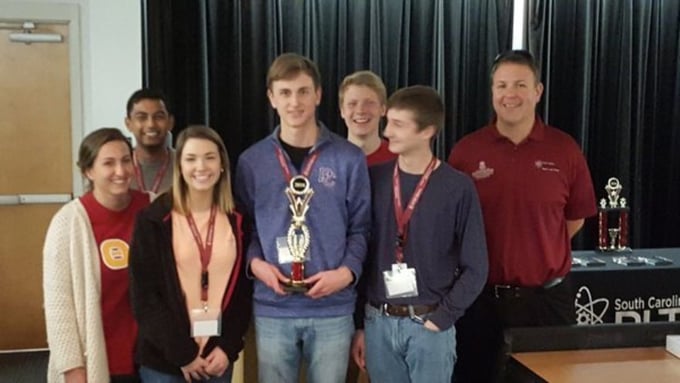John Michael Hammond is a science and PLTW Engineering teacher at Clinton High School in Clinton, South Carolina. He teaches Introduction to Engineering Design (IED), Principles of Engineering (POE), Civil Engineering and Architecture (CEA), and Environmental Sustainability (ES).
Five years ago, I was a young, naïve science teacher eager to change the world. I made it through college and had a very successful student teaching experience, so I was champing at the bit to get my own chemistry classroom. Unfortunately, like far too many teachers today, I was all but burned out after a couple years in the classroom. I felt like I had so many great ideas, but I was just unable to make them come to fruition due to what felt like insufficient resources, lack of support, and the overwhelming task of trying to basically develop my own hands-on, project-based curriculum.
Deciding that I needed to make a change, I took a new job as a Project Lead The Way teacher at a high-poverty, rural school in upstate South Carolina. The task seemed daunting at first – I was building a brand-new program from the ground up – but I was excited to try something new.
After two years teaching both Introduction to Engineering Design (IED) and Principles of Engineering (POE), the change in my classroom is remarkable. While things are certainly not perfect and I am still striving to improve, it is easy to pinpoint major differences.
My students have become independent critical thinkers due to the PLTW curriculum that encourages them to solve problems for themselves rather than following a prescribed routine. They are constantly asking deep, thought-provoking questions during (and outside of) class related to engineering concepts that we discuss. Other teachers have told me that the collaboration and communication skills developed in PLTW class have translated to their classes, as well.
The classroom environment is different; while we are always busy with something, students are not as stressed out and are much more engaged. Furthermore, students in underrepresented STEM fields (African-American students, girls, etc.) are thriving in our program.
This positive effect is even evident in extracurriculars: We are starting two brand-new VEX robotics teams this year, composed entirely of PLTW students. Four of my students entered and won an engineering design challenge at Clemson University, spending countless hours of their free time working in the PLTW lab to design and construct a renewable energy light source for students in Haiti. Our Science Olympiad team won a state championship, aided by several PLTW students. We are also successfully operating a MakerSpace where students have a chance to tinker and explore their own interests. PLTW students sometimes even serve as mentors during this time, teaching skills such as 3-D modeling or robotics programming to students who are not part of the PLTW program.
I credit Project Lead The Way for much of this transformation. PLTW has provided me with the tools, training, resources, and network to accomplish what I want as a teacher. I am constantly rejuvenated when I see my students experience the type of authentic growth that was all too rare in my previous classroom. After traveling to PLTW Summit 2016 and attending two more Core Trainings during the summer (CEA and ES), I am extremely excited about the future of PLTW at my school.
PLTW’s blog is intended to serve as a forum for ideas and perspectives from across our network. The opinions expressed are those of this guest author.


